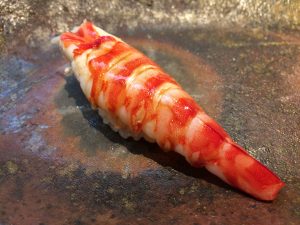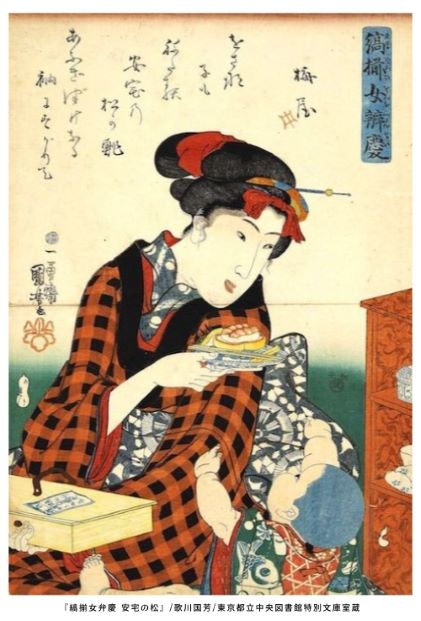
Crustaceans like shrimp and crab are sushi toppings overflowing with their distinctive sweetness.
Except for Kuruma ebi, Ebi and Kani (shrimp and crab) were introduced as sushi toppings after WWII. The sweetness of shrimp is stronger when eaten raw. There is still a sweetness remaining in boiled shrimp, but it’s weaker. Instead, the umami gets stronger and the texture is also completely different than when served raw. When boiled the fiber is more apparent and it can be bitten clear through. Kuruma ebi is one of the traditional sushi toppings of the Edo period.
The umami of shrimp is sweeter than that of crab. The sweetness comes from the amino acids contained in the extract: glycine, arginine, alanine, propurine, and betaine. In particular, Kurumaebi and amaebi are particularly rich in glycine. On the other hand, umami is related to ATP decomposition-related substances.

Crab wasn’t originally an Edomae sushi topping. However, there is a special sweetness that oozes from the gaps in the fibrous body. The umami of crab is the amino acids in the extract component. Among crabs, hairy crabs have the most amino acids, while those of snow crabs, a high-end winter delicacy, are less abundant than those of hairy crabs, and therefore less rich in flavor. Nucleic acid-related substances are mainly CMP, but ATP-degrading substances such as AMP and inosinic acid are also involved in the umami taste. The main component of sweetness is glycine betaine, a sugar alcohol-based component.
*Japanese terms will be italicized on sushi ingredients page.
<Ebi/Kani-Prawn/Crab>
Aburagani-Blue king crab (Paralithodes platypus (Brandi,1850))
Aka ebi-Argentine Red Shrimp (Pleoticus muelleri (Spence Bate, 1888))
Akashimamoebi-Indian lined shrimp (Lysmata vittata (Stimpson, 1860))
Akaza ebi-Japanese lobster (Metanephrops japonicus (Tapparone Canefri,1873))
Ama ebi-Deepwater prawn (Deepwater shrimp, Pink prawn)
Ashinagamoebi-Toy shrimp (Heptacarpus futilirostris (Spence Bate, 1888))
Australia Iseebi-Australian spiny lobster (Panulirus cygnus George, 1962)
Benizuwaigani-Red snow crab, Red tanner crab (Chionoecetes japonicus Rathbun, 1932)
Black tiger (Ushi ebi)-Black tiger
Botan ebi-Botan shrimp (Pink prawn, Pink shrimp)
Botan ebi-Spot prawn
Budou ebi-Grape shrimp
Gasa ebi (Mosa ebi)-Gas shrimp or Mosa shrimp (Argis lar (Owen, 1839)) or (Argis toyamaensis (Yokoya,1933))
Gazami (Watarigani)-Blue swimming crab (Portunus (Portunus) trituberculatus (Miers.1876))
Hanasakigani-Hanasaki crab (Paralithodes brevipes (H. Milne-Edwards & Lucas, 1841))
Himeamaebi- (Plesionika semilaevis Spence Bate, 1888)
Hokkaiebi- Hokkai shrimp (Pandalus latirostris Rathbun, 1902)
Ibaramo ebi (Oni ebi)-Spiny Lebbeid (Lebbeus groenlandicus(Fabricius,1775))
Ise ebi-Japanese spiny lobster
Izumiebi-(Plesionika izumiae Omori, 1971)
Higenagaebi-Jack-knife shrimp (Haliporoides sibogae (De Man,1911))
Hikarichihiroebi-Stout red shrimp (Aristeus virilis (Spence Bate, 1881))
Jinkenebi-Golden shrimp (Plesionika semilaevis Bate, 1888)
Kegani-Horsehair crab (Korean crab, Kegani crab)
Kuma ebi (Ashiaka)-Green tiger prawn (Penaeus semisulcatus De Haan.1844)
Kurigani-Helmet crab (Telmessus cheiragonus (Tilesius, 1812) )
Kuruma ebi-Kuruma prawn (Gadus macrocephalus Tilesius, 1810)
Naikaisujiebi-Chinese ditch prawn (Palaemon gravieri (Yü, 1930))
Namikudahigeebi -Razor mud shrimp (Solenocera melantho De Man, 1917)
Sakura ebi-Sakura shrimp (Sergia lucens (Hansen,1922))
Shako-Squilla (Mantis shrimp, Edible mantis shrimp)
Shiba ebi-Shiba shrimp (Metapenaeus joyneri (Miers.1880))
Shima ebi-Morotoge shrimp
Shiro ebi (Shira ebi)-Japanese glass shrimp
Takaashigani-Japanese giant crab (Macrocheria kaempferi (Temminck,1836))
Tarabagani-King crab, Alaska king crab, Red king crab (Paralithodes camtschaticus (Tilesius,1815))
Tenshinoebi-Paradise prawn (Penaeus stylirostris Stimpson, 1874)
Toyama ebi (Botan ebi)-Hamupback shrimp
Uchidazarigani-Signal crayfish (Pacifastacus trowbridgii (Stimpson,1857))
Uchiwa ebi-Sand crayfish, Flathead lobster, Balmain bug, Slipper lobster
Zouriebi-Japanese mitten lobster (Pariibacus japonicus Holthuis,1960)
Zuwaigani-Snow crab, Queen crab, Zuwai-crab (Chionoecetes opilio (O.Fabricius,1788))
[sc_apply url=”https://sushiuniversity.jp/apply/”]
We hope this information will be helpful.

Revision date: March 11, 2025
Share this article